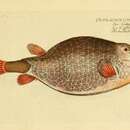Diagnostic Description
provided by Fishbase
Males with blue line and spots that fade rapidly (Ref. 3141).Description: Characterized further by pale grey to yellowish brown color with darker brown network of hexagons and small blue spots or large spots enclosing stellate pale lines; triangular carapace with moderately elevated dorsal ridge containing two small spines on middle portion; straight to slightly concave dorsal profile of snout; truncate to slightly rounded caudal fin; dorsal and ventral ridges of postlarval juvenile with large spines (Ref. 90102).
- Recorder
- Cristina V. Garilao
Morphology
provided by Fishbase
Dorsal spines (total): 0; Dorsal soft rays (total): 9; Analspines: 0; Analsoft rays: 9 - 10
- Recorder
- Cristina V. Garilao
Biology
provided by Fishbase
Enters muddy bays or estuaries; usually with large remote sponges (Ref. 48637). Solitary. Also found in seagrass and weed bottoms of coastal reefs (Ref. 90102).
Comprehensive Description
provided by Smithsonian Contributions to Zoology
Tetrosomus concatenatus (Bloch)
The subdivision of A 2 is not at all clear, and A 1β′ is hardly distinguishable from A 1α”. The levator arcus palatini is fairly small, and there is no dorsal bundle of fibers to the dorsomedial face of the tendon of the retrator arcus palatini. The subdivisions of the sternobranchialis are not as clear as in either of the previous species. Levator internus II is extremely well developed, with a broad insertion on infrapharyngobranchial 2. The obliquus posterior is somewhat reduced. The hypochordal longitudinalis inserts by a broad, undivided tendon on the bases of rays D 3–5, while the transversus caudalis inserts on rays V 3–5.
- bibliographic citation
- Winterbottom, Richard. 1974. "The familial phylogeny of the Tetraodontiformes (Acanthopterygii: Pisces) as evidenced by their comparative myology." Smithsonian Contributions to Zoology. 1-201. https://doi.org/10.5479/si.00810282.155
Tetrosomus concatenatus: Brief Summary
provided by wikipedia EN
The triangular boxfish (Tetrosomus concatenatus) is one of four fish species in the genus Tetrosomus in the boxfish family. It reaches a maximum length of 30 cm (12 in).
- license
- cc-by-sa-3.0
- copyright
- Wikipedia authors and editors

